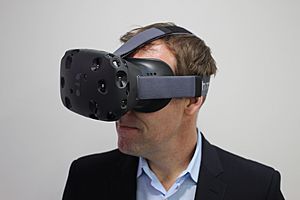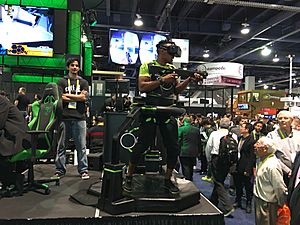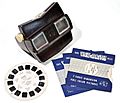Virtual reality facts for kids
Virtual reality (often called VR) is a cool computer technology that makes you feel like you are somewhere else. It uses special computer programs to create pictures, sounds, and other feelings. This makes you believe you are really part of a different place. That place can be real, like taking a tour in another country, or imaginary, like playing a game.
To experience VR, you usually wear a special headset. This headset has screens to show you the virtual world and speakers for sounds. The pictures often change when you move your head. You might even be able to "walk" through this virtual space and see things from different angles. Sometimes, special gloves give you "haptic feedback." This means they make you feel like you are touching things in the virtual world.
Virtual reality is different from augmented reality (AR). AR shows you the real world around you but adds computer-generated things to it. Think of games like Pokémon Go as an example of augmented reality.
Contents
How VR Works
There are different ways to experience virtual reality. Some methods make you feel more immersed than others.
Simulation VR
This type of VR makes you feel like you are doing something real. For example, a driving simulator can make you feel like you are actually driving a car. This is often used for training.
Avatar VR
In avatar-based VR, you can join a virtual world as a digital character, called an avatar. You can also sometimes appear as a real video of yourself. This lets you interact with others in a 3D virtual space.
Projector VR
Some VR systems use projectors to create a virtual environment. This is often used for things like robot navigation or designing buildings. It helps create realistic models of real places.
Desktop VR
You can experience some virtual worlds on a regular computer screen. This is called desktop VR. Many modern first-person video games are like this. They use different triggers and characters to make you feel like you are in the game. However, you don't get the full feeling of being "inside" the world because you can't see things in your side vision.

Headset VR
A head-mounted display (HMD) or virtual reality headset gives you a much more immersive experience. These headsets usually have two small, high-resolution screens, one for each eye. This creates a 3D view of the virtual world. They also have special sound systems and track your head movements. This means if you turn your head, the virtual world moves with you. Some headsets also come with motion controls that let you move your hands and body freely in the virtual space.
Mixed Reality (MR)
Mixed reality combines the real world and virtual worlds. It creates new environments where real and digital objects can exist and interact together at the same time.
Things to Think About with VR
While VR is amazing, there are some important things to consider, especially about your health and safety, and privacy.
Health and Safety with VR
Using VR can sometimes cause a few issues. Many VR systems come with warnings.
- Motion Sickness: Some people feel like they have motion sickness when using VR. This is also called "cybersickness." It happens when what your eyes see doesn't match what your body feels. For example, if you see yourself moving fast in VR but your body is standing still, you might feel sick. Symptoms can include headaches, stomach aches, or feeling dizzy. To avoid this, make sure the VR system runs smoothly without lag.
- Eye Strain: Like all screens, VR headsets can cause eye fatigue. People tend to blink less when looking at screens, which can make eyes feel dry. It's a good idea to take breaks.
- Physical Safety: When you wear a VR headset, you might forget about your real surroundings. It's important to be careful not to trip over things or bump into objects in your room. Always make sure you have enough clear space to move around safely.
- Children and VR: Some studies show that VR can feel very real to children. Because VR headsets can be heavy, they might be uncomfortable for younger kids. It's often suggested that children take breaks and use VR under adult supervision.
Privacy in VR
VR systems collect a lot of information about you. This is because they need to track your movements and how you react in the virtual world.
- What Data is Collected: VR platforms can collect things like your username, how you move your body, how you interact with virtual objects, and even your eye movements. This data helps improve the VR experience and can be used for things like personalized content.
- Why it Matters: This information is personal. It's important to know how companies use and share this data. Laws like the General Data Protection Regulation (GDPR) in Europe and the California Consumer Privacy Act (CCPA) in the U.S. help protect your privacy. They require companies to tell you what data they collect and give you some control over it.
- Being Aware: As VR becomes more popular, it's good to be aware of what information you are sharing. Always check the privacy settings and policies of the VR apps and platforms you use.
Images for kids
-
Researchers with the European Space Agency in Darmstadt, Germany, demonstrating how astronauts might use virtual reality to train for missions.
-
NASA Ames's 1985 VIEW headset prototype.
-
The Project Morpheus (PlayStation VR) headset worn at gamescom 2015.
-
The Smartphone-based Samsung Gear VR headset.
-
Apollo 11 astronaut Buzz Aldrin previewing the Destination: Mars VR experience in 2016.
-
U.S. Navy medic demonstrating a VR parachute simulator in 2010.
See also
 In Spanish: Realidad virtual para niños
In Spanish: Realidad virtual para niños













